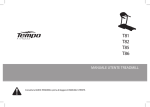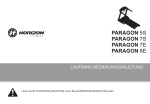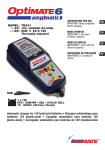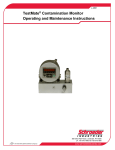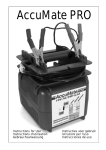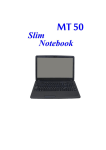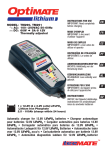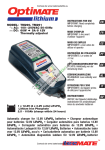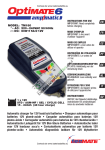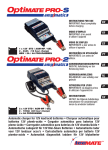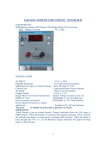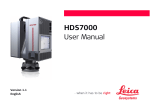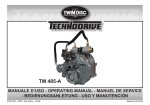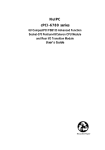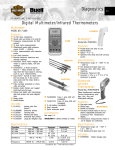Download Manual Instrucciones Cargador baterias OPTIMATE LITHIUM TM470
Transcript
Cortesia de www.bateriasdelitio.eu MODEL: TM470 / TM471 / TM472 AC: 100 – 240VAC 50-60Hz 0.23A @ 100Vac / 0.15A @ 240Vac DC: 0.8A 12.8V 1 x 12.8V 4 series cell + - Lithium Iron Phospate / LFP 2.5 - 30Ah MODEL: TM484 / TM485 / 486 AC: 100 – 240VAC 50-60Hz 0.92A @ 100Vac / 0.60A @ 240Vac DC: 4 x 0.8A 12.8V (independent) 4 x 12.8V 4 series cell + - Lithium Iron Phospate / LFP 2.5 - 30Ah INSTRUCTIONS FOR USE IMPORTANT: Read completely before charging MODE D’EMPLOI IMPORTANT: à lire avant d’utiliser l’appareil MODO DE EMPLEO IMPORTANTE: a leer antes de utilizar el aparato INSTRUÇÕES DE UTILIZAÇÃO IMPORTANTE: Ler antes de utilizar. ANWENDUNGSVORSCHRIFTEN WICHTIG: Vollständig vor der Benutzung lesen GEBRUIKSAANWIJZING BELANGRIJK: Lees volledig voor gebruik ISTRUZIONI PER L’USO IMPORTANTE: da leggere prima di utilizzare l’apparecchio INSTRUKTIONER VIKTIGT: läs följande fullständiga instruktioner för användningen innan du använder laddaren Automatic charger for 12.8V LiFePO4 batteries • Chargeur automatique pour batteries 12.8V LiFePO4 • Cargador automático para baterías 12.8V LiFePO4 • Carregador automático para baterias de 12.8V LiFePO4 • Automatische Ladegerät für 12.8V LiFePO4 Batterien • Automatische lader voor 12.8V LiFePO4 accu’s • Caricabatterie automatico per batterie 12.8V LiFePO4 • Automatisk diagnostisk laddare för 12.8V LiFePO4-batterier Cortesía de www.bateriasdelitio.eu Cortesia de www.bateriasdelitio.eu Multi bank / station model OptiMate Lithium 0.8 x4 : each bank /station / output operates as an independent OptiMate Lithium 0.8. LFP . 1234 #5 #1 #2 #6 SAVE #3 CHARGE 0.8 #4 LED #1 - AC POWER (100-240V) LED #2 - Reverse polarity LED #3 - SAVE/DESULPHATE LED #4 - CHARGE LED #5 - GREEN: TEST & MAINTAIN LED #6 - RED: TEST & MAINTAIN Cortesía de www.bateriasdelitio.eu Cortesia de www.bateriasdelitio.eu THIS PORTION OF THE MANUAL CONTAINS IMPORTANT SAFETY INSTRUCTIONS FOR THE OptiMate LITHIUM BATTERY CHARGER. IT IS OF THE UTMOST IMPORTANCE THAT EACH TIME, BEFORE USING THE CHARGER, YOU READ AND EXACTLY FOLLOW THESE INSTRUCTIONS. SAVE THESE INSTRUCTIONS. AUTOMATIC CHARGER FOR 12.8V LIFEPO4 (LITHIUM IRON PHOSPHATE ) BATTERIES. DO NOT USE FOR NiCd, NiMH, Lead-Acid or any other type of Li-Ion OR NON-RECHARGEABLE BATTERIES. 1. CAUTION : CLASS II APPLIANCE. DO NOT CONNECT TO GROUND. 2. For indoor use only. Do not expose charger to rain or snow. 3. Use of an attachment not recommended or sold by the battery charger manufacturer may result in a risk of fire, electric shock,or injury to persons. 4. To reduce risk of damage to electric plug and cord,pull by plug rather than cord when disconnecting charger. 5. An extension cord should not be used unless absolutely necessary. Use of improper extension cord could result in a risk of fire and electric shock.If extension cord must be used make sure that : a) pins on plug of extension cord are the same number, size and shape as those of plug on charger. b) the extension cord is property wired and in good electrical condition,and c) the conductor wire size is large enough for the AC ampere rating of the charger as specified in the table below. AC INPUT RATING IN AMPERES Equal to or greater than But less than 2A LENGTH OF CORD, FEET (m) AWG SIZE OF CORD 25 (17.6) 50 (15.2) 100 (30.5) 18 18 14 3A 6. Do not operate charger with damaged cord or plug - replace the cord or plug immediately. 7. Do not operate charger if it has received a sharp blow, been dropped,or otherwise damaged in any way; take it to a qualified serviceman. 8. Do not disassemble charger; take it to a qualified serviceman when service or repair is required. Incorrect reassembly may result in a risk of electric shock or fire. 9. To reduce risk of electric shock, unplug the charger from outlet before attempting any maintenance or cleaning. Turning off controls will not reduce this risk.Clean only with slightly moist,not wet, cloth.Do not use solvents. 10. WARNING - RISK OF EXPLOSIVE GASES. a) WORKING IN VICINITY OF A LEAD-ACID BATTERY IS DANGEROUS. B ATTERIES GENERATE EXPLOSIVE GASES DURING NORMAL BATTERY OPERATION. FOR THIS REASON, IT IS OF UTMOST IMPORTANCE THAT YOU FOLLOW THE INSTRUCTIONS EACH TIME YOU USE THE CHARGER. b) To reduce risk of battery explosion,follow these instructions and those published by the battery manufacturer and manufacturer of any equipment you intend to use in vicinity of the battery. Review cautionary marking on these products and on engine. 11. PERSONAL PRECAUTIONS. a) Someone should be within range of your voice OR close enough to come to your aid when you work near a lead-acid battery. b) Have plenty of fresh water and soap nearby in case battery acid contacts skin, clothing or eyes. c) Wear complete eye protection and clothing protection. Avoid touching eyes while working near battery. d) If battery acid contacts or enters eye, flood eye with cold running water for at least 10 minutes and get medical attention immediately. If battery acid contacts skin or clothing, wash immediately with soap & water. If acid enters an eye , immediately flood eye with running cold water for at least 10 minutes & get medical attention immediately. e) NEVER smoke or allow a spark or flame in vicinity of battery or engine. f) Be extra cautious to reduce risk of dropping a metal tool onto battery. It might spark or short-circuit battery or other electrical part that may cause explosion. g) Remove personal metal items such as rings, bracelets ,necklaces , and watches when working with a lead-acid battery. A lead-acid battery can produce a short-circuit current high enough to weld a ring or the like to metal, causing a severe burn. i) NEVER charge a frozen battery. Cortesía de www.bateriasdelitio.eu 3 SAFETY IMPORTANT SAFETY INSTRUCTIONS FOR CANADA & USA Cortesia de www.bateriasdelitio.eu 12. PREPARING TO CHARGE SAFETY US & CAN a) If necessary to remove battery from vehicle to charge,always remove grounded terminal from battery first. Make sure all accessories in the vehicle are off, so as not to cause an arc. b) Be sure area around battery is well ventilated while battery is being charged. Gas can be forcefully blown away by using a piece of cardboard or other non-metallic material as a fan. c) Clean battery terminals.Be careful to keep corrosion from coming in contact with eyes. d) Add distilled water in each cell until battery acid reaches level specified by battery manufacturer. This helps purge excessive gas from cells. Do not overfill. For a battery without cell caps, such as valve regulated lead acid (VRLA) or absorbed glass mat (AGM) batteries, carefully follow manufacturer’s recharging instructions. e) Study all battery manufacturer’s specific precautions such as removing or not removing cell caps while charging and recommended rates of charge. f) Determine voltage of battery by referring to vehicle or other user’s manual and BEFORE MAKING THE BATTERY CONNECTIONS, MAKE SURE TH AT THE VOLTAGE OF THE BATTERY YOU ARE GOING TO CHARGE MATCHES THE OUTPUT VOLTAGE OF THE CHARGER. 13. CHARGER LOCATION. a) Locate charger as far away from battery as DC cables permit. b) Never place charger directly above batterv being charged; gases from battery will corrode and damage the charger. c) Never allow battery acid to drip on charger when reading gravity or filling battery. Do not operate charger in a closed-in area or restrict ventilation in any way. d) Do not set a battery on top of charger. IMPORTANT : Place charger on a hard flat surface or mount onto a vertical surface. Do not place on plastic, leather or textile surface. 14. DC CONNECTION PRECAUTIONS a) Connect and disconnect DC output clips only after setting any charger switches to off position and removing AC cord from electric outlet. Never allow clips to touch each other, however should this happen no damage will result to the charger circuit & the automatic charging programme will just reset to «start». b) Attach clips to battery and chassis as indicated in 15(e), 15(f), and 16(b) through 16(d). NOTE : This battery charger has an automatic safety feature that will prevent it from operating if the battery has been inversely connected. Set charger switches to off position and/or remove AC cord from electrical outlet, disconnect the battery clips, then reconnect correctly according to the instructions below. 15. FOLLOW THESE STEPS WHEN BATTERY IS INSTALLED IN VEHICLE. A SPARK NEAR A BATTERY MAY CAUSE BATTERY EXPLOSION. TO REDUCE RISK OF A SPARK NEAR BATTERY : a) Position AC and DC cords so as to reduce risk of damage by hood, door or moving engine part. b) Stay clear of fan -blades, belts,pulleys,and other parts that can cause injury to persons. c) Check polarity of battery posts.POSITIVE (POS, P, +) battery post usually has larger diameter than NEGATIVE (NEG, N,–) post. d) Determine which post of battery is grounded (connected) to the chassis. If negative post is grounded to chassis (as in most vehicles),see (e). If positive post is grounded to the chassis,see (f). e) For negative-grounded vehicle, connect POSITIVE (RED) clip from battery charger to POSITIVE (POS, P, + ) ungrounded post of battery. Connect NEGATIVE (BLACK) clip to vehicle chassis or engine block away from battery. Do not connect clip to carburetor, fuel lines, or sheet-metal body parts. Connect to a heavy gage metal part of the frame or engine block. f) For positive-grounded vehicle, connect NEGATIVE (BLACK) clip from battery charger to NEGATIVE (NEG. N , -) ungrounded post of battery. Connect POSITIVE (RED) clip to vehicle chassis or engine block away from battery. Do not connect clip to carburetor, fuel lines, or sheet-metal body parts. Connect to a heavy gage metal part of the frame or engine block. g) When disconnecting charger, turn switches to off, disconnect AC cord,remove clip from vehicle chassis,and then remove clip from battery terminal. h) See operating instructions for length of charge information. 16. FOLLOW THESE STEPS WHEN BATTERY IS OUTSIDE VEHICLE. A SPARK NEAR THE BATTERY MAY CAUSE BATTERY EXPLOSION. TO REDUCE RISK OF A SPARK NEAR BATTERY : a) Check polarity of battery posts. POSITIVE (POS, P, +) battery post usually has a larger diameter than NEGATIVE (NEG,N, -) post. b) This battery charger has an automatic safety feature that will prevent it from operating if the battery has been inversely connected. The charger does allow charge current unless a voltage of at least 2V is sensed. c) Connect POSITIVE (RED) charger clip to POSITIVE (POS, P, +) post of battery. d) Connect NEGATIVE (BLACK) charger clip to NEGATIVE (NEG, N, -) battery post of the battery. e) Do not face battery when making final connection. f) When disconnecting charger, always do so in reverse sequence of connecting procedure & break first connection while as far away from battery as practical. g) A marine (boat) battery must be removed & charged on shore. To charge it on board requires equipment specially designed for marine use. 4 Cortesía de www.bateriasdelitio.eu Cortesia de www.bateriasdelitio.eu AUTOMATIC DIAGNOSTIC CHARGER FOR 12.8V LiFePO4 (LITHIUM IRON PHOSPHATE ) BATTERIES FROM 2.5Ah TO 30Ah: maximum 0,23A. The maximum output current is 0,8A. SAFETY WARNING AND NOTES: IF YOU HAVE NOT YET DONE SO, READ THE PRECEDING PAGES LABELLED "IMPORTANT SAFETY INSTRUCTIONS" BEFORE OPERATING THIS CHARGER. This appliance is not intended for use by persons (including children) with reduced physical, sensory or mental capabilities, or lack of experience and knowledge, unless they have been given supervision or instruction concerning use of the appliance by a person responsible for their safety. Children should be supervised to ensure that they do not play with the appliance. USING THE OPTIMATE LITHIUM 0.8A CORRECT USE: Use the charger only if the input and output leads and connectors are in good, undamaged condition. If the input cable is damaged, it is essential to have it replaced without delay by the manufacturer, his authorised service agent or a qualified workshop, to avoid danger. Protect your charger from damp and humid conditions both during use and in storage. Damage resulting from corrosion, oxidation or internal electrical short-circuiting is not covered by warranty. Distance the charger from the battery during charging to avoid contamination by or exposure to acid or acidic vapours. If using it in the horizontal orientation, place the charger on a hard, flat surface, but NOT on plastic, textile or leather. Use the fixing holes provided in the enclosure base to attach the charger to any convenient, sound vertical surface. EXPOSURE TO LIQUIDS: This charger is designed to withstand exposure to liquids accidentally spilled or splashed onto the casing from above, or to light rainfall. Prolonged exposure to falling rain is inadvisable and longer service life will be obtained by minimizing such exposure. Failure of the charger due to oxidation resulting from the eventual penetration of liquid into the electronic components, connectors or plugs, is not covered by warranty. VERY FLAT NEGLECTED BATTERIES: Pay particularly close attention to the following A LiFePO4 battery left deep-discharged for an extended period may develop permanent damage in one or more cells. Such batteries may heat up excessively during charging. During the SAVE mode the program limits charge current if the voltage is below 12.8V and the program should detect obvious cell damage and will automatically suspend charging, but the higher the cell count in parallel the more difficult it is to detect a bad cell e.g. a 5Ah battery typically has 4 series connected sets of 2 parallel cells (4S2P configuration - total 8 cells), a 10Ah battery has 4 series connected sets of 4 parallel cells (4S4P configuration - total 16 cells). ALWAYS monitor the battery temperature during the first hour, then hourly there-after. If at any time the battery is uncomfortably hot to touch or you notice any unusual signs, DISCONNECT THE CHARGER IMMEDIATELY. CHARGING TIME Charge time on a flat but otherwise undamaged battery: For batteries rated from 2.5Ah to 5Ah: 180 to 360 minutes to progress to the voltage retention test. For batteries rated above 5Ah: 125% of the battery’s Ah rating, so a 30Ah battery should take no more than about 38 hours to progress to the voltage retention test. Deep-discharged batteries may take significantly longer. A full charge may not be achieved within the 24 hour charge safety limit. In this case follow the reset procedure below. RESETTING THE CHARGE & TEST CYCLE Disconnect from the AC mains. Wait for the POWER ON LED #1 to go out. Upon reconnection to AC power LEDs #3, 4, 5 and 6 will flash twice to confirm micro processor health, irrespective if the charger remains connected to a battery or not. ECO POWER SAVING MODE WHEN THE CHARGER IS CONNECTED TO AC SUPPLY: The power converter switches to ECO mode when the charger is not connected to a battery resulting in a very low power draw of less than 0.5W (per charging bank), equivalent to power consumption of 0.012 kWh per day. When a battery is connected to the charger power consumption depends on the current demand of the battery and its connected vehicle / electronic circuitry. After the battery has been charged and the charger is in long term maintenance charge mode (to keep the battery at 100% charge) the total power consumption is estimated to be 0.024 kWh or less per day. Cortesía de www.bateriasdelitio.eu 5 SAFETY Input: 100-240V Cortesia de www.bateriasdelitio.eu PROCEEDING TO CHARGE The LED indicators below are sequenced as they may come on through the course of the program. LED #5 - GREEN: TEST & MAINTAIN LED #1 - AC POWER (100-240V) LED #6 - RED: TEST & MAINTAIN LED #2 - Reverse polarity SAVE LED #3 - SAVE CHARGE 0.8 LED #4 - CHARGE POWER ON: LED #1 - Confirms AC power supply to the charger. HIGH and LOW intensity indication: The"POWER ON" LED #1 will indicate brightly when current is delivered to the battery. The "POWER ON" LED #1 will reduce intensity to a low level to indicate low power "ECO" mode. This will occur if there is no battery connected, or when a battery is connected and the program finds itself in the voltage retention test mode or the 'rest' periods of Maintenance Charge mode. REVERSE POLARITY PROTECTION: LED #2 - Lights when the battery connections are incorrect. The charger is electronically protected so no damage will result, and the output will remain disabled until the connections are corrected. LED #3 SAVE lights If the battery is extremely flat (deep-discharged), IMPORTANT: If this mode engages read the section VERY FLAT NEGLECTED BATTERIES . This mode engages if the battery was more than 90% discharged / voltage is below 12.8V. Charge current is automatically adjusted according to voltage measured . VERY LOW VOLTAGE SAVE for batteries between 0.6V and 8.8V: Current starts at 200mA and will increase to 325mA depending on charge progress. If the voltage did not rise above 8.8V within 2 hours, charging will be suspended and the TEST LED #6 (red) will flash, indicating the battery may have suffered permanent damage or a professional assessment is required. LOW VOLTAGE SAVE for batteries between 8.9V and 12.8V: Maximum current is set to 0.8A. The battery's charge acceptance is monitored for unusual behaviour. A healthy LiFePO4 battery will progress to CHARGE mode within 4 hours, otherwise charging will be suspended and TEST LED #6 (red) will flash, indicating the battery may have suffered permanent damage or a professional assessment is required. LED #4 Charge and charge verification CHARGE: The BULK CHARGE stage delivers a constant current of about 0,8 Amps maximum into the battery, up to a voltage of 14,2 -14,4V. VERIFICATION: The circuit verifies battery charge level. If the battery requires further charging the programme reverts to BULK CHARGE for brief periods, delivering a variable current pulse to the battery. These reversions may occur as many times as is necessary to reduce the battery’s current demand below 200mA at 13,6V (which is consistent with a battery that has accepted as much charge as its basic condition allows). (see expected Charging time.) NOTE: For safety reasons there is an overall charge time limit of 48 hours. VOLTAGE RETENTION TEST: LED #5 flashing Delivery of current to the battery is interrupted for 12 hours* to allow the program to determine the battery's ability to retain charge. For batteries with a good state of health LED #5 (green) should continue to flash for the full 12 hours* period. Read the section NOTES ON TEST RESULTS on reasons for poor test results or how to test a battery that returns a good result but cannot deliver sufficient power once it is returned to service. MAINTENANCE CHARGE: LED #5 / 6 steady on For 30 minutes the circuit offers current to the battery within a safe 13,6V voltage limit whilst the result of the voltage retention test is displayed. If LED #6 (red) indicated the VOLTAGE RETENTION TEST will be repeated. A steady LED #5 (green) indicate the 30 minute float charge maintenance periods follow and alternate wih the 30 minute REST (no charging) periods until the battery is disconnected. The battery can draw current as required to support small loads and counter self-discharge. 6 Cortesía de www.bateriasdelitio.eu Cortesia de www.bateriasdelitio.eu NOTES ON TEST RESULTS: 1. For any test result other than green #5, disconnect the battery from the electrical system it supports, and reconnect the OptiMate. If a better test result is now obtained, this suggests that the power losses are partly due to an electrical problem in the electrical system and not in the battery itself. If the poor result persists, you are advised to take the battery to a professional service workshop equipped with professional equipment for a more thorough investigation. 2. If the red LED #6 alone, or the GREEN #5 and red LED #6 indicate together, a significant problem exists. The green + red LEDs mean that after being charged the battery’s voltage is not being sustained or that despite recovery attempts the battery was irrecoverable. This may be due to a defect in the battery itself, such as a short-circuited cell or total sulphation, or, in the case of a battery still connected to the electrical system it supports, the red LED #6 may be signalling a loss of current through deteriorated wiring or a degraded switch or contact, or in-circuit current-consuming accessories. A sudden load being switched on while the charger is connected can also cause the battery voltage to dip significantly. 3. GOOD TEST RESULT, but the battery cannot deliver sufficient power: Permanent damage within the battery may be causing excessive self discharge that is not detected within the test period of 12 hours. Disconnect the battery from the OptiMate. AUTOMATIC BATTERY MAINTENANCE: The MAINTENANCE CHARGE CYCLE consists of 30 minute charge periods followed by and alternating with a 30 minute ‘rest’ periods, during which there is no charge current. The circuit offers current to the battery within a safe 13.6V voltage limit (“float charge”), allowing it to draw whatever small current is necessary to sustain it at full charge and compensate for any small electrical loads imposed by connected circuitry, or the natural gradual self-discharge of the battery itself. The BATTERY REFRESH CYCLE is performed if the charger detects the battery has lost charge. The program returns to OPTIMIZE mode (LED #4) and then proceeds to the voltage retention test and maintenance charge cycle. LIMITED WARRANTY TecMate (International) SA, Sint-Truidensesteenweg 252, B-3300 Tienen, Belgium, makes this limited warranty to the original purchaser at retail of this product. This limited warranty is not transferable. TecMate (International) warrants this battery charger for three years from date of purchase at retail against defective material or workmanship. If such should occur the unit will be repaired or replaced at the option of the manufacturer. It is the obligation of the purchaser to forward the unit together with proof of purchase (see NOTE), transportation or mailing costs prepaid, to the manufacturer or its authorized representative. This limited warranty is void if the product is misused, subjected to careless handling, or repaired by anyone other than the factory or its authorized representative. The manufacturer makes no warranty other than this limited warranty and expressly excludes any implied warranty including any warranty for consequential damages. THIS IS THE ONLY EXPRESS LIMITED WARRANTY AND THE MANUFACTURER NEITHER ASSUMES NOR AUTHORIZES ANYONE TO ASSUME OR MAKE ANY OTHER OBLIGATION TOWARDS THE PRODUCT OTHER THAN THIS EXPRESS LIMITED WARRANTY. YOUR STATUTORY RIGHTS ARE NOT AFFECTED. NOTE: Details at www.tecmate.com/warranty. copyright © 2014 TecMate International OptiMate, OptiMate Lithium and the names of other battery care products mentioned in these instructions such as BatteryMate, TestMate and TestMate mini, are registered trademarks of TecMate International NV. WARRANTY in Canada, USA, Central America & South America: TecMate North America, Oakville, ON, Canada, as a wholy owned subsidiary of TecMate International, assumes the responsibility for product warranty in these regions. More information on TecMate products can be found at www.tecmate.com. Cortesía de www.bateriasdelitio.eu 7







